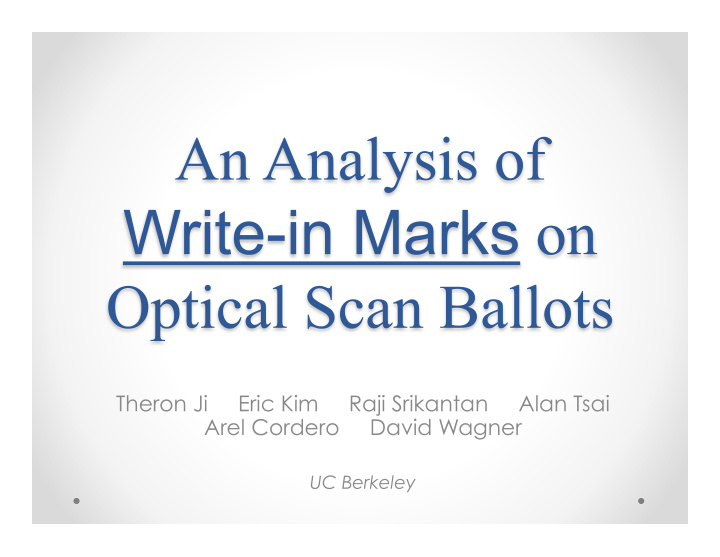



Theron Ji Eric Kim Raji Srikantan Alan Tsai Arel Cordero David Wagner UC Berkeley
• Widely used in today’s elections • Voters indicate choices by marking voting targets • Scanner tabulates votes by detecting marks
• Region where write-in candidates are written in by the voter • Corresponding voting target must be filled for vote to count • So does this happen?
• Lisa Murkowski wins the 2010 Alaska Senate election through a write-in campaign • Donna Frye narrowly loses the 2004 San Diego mayoral election because people forgot to mark the write-in voting target
• Voter writes in a candidates name, but doesn’t fill in the corresponding voting target – vote is lost • Questions: o How often does this occur? o What trends are there when this happens? o How do you detect this accurately, quickly, and with minimal human effort?
1. Given a large dataset of scanned ballots, develop a system to accurately and efficiently detect write- in marks without using the corresponding voting target 2. Apply this to a real election and examine the results to see how voters actually use write-in slots on ballots and infer trends or possible sources of error
• We were kindly given 248,334 scanned, double-sided ballot images from the 2008 Leon County General Election (thanks to Larry Moore, Ion Sancho, and Clear Ballot Group) • These were in the Premier (Diebold) optical scan format
• We assume we are given blank templates • We assume ballots have a regular and consistent structure • (We don’t assume to know write-in locations) • (We don’t assume scanned image will be perfect)
• Align each ballot to a universal coordinate system • Necessary for accuracy of further steps • Robust against folds, skews, and tears in images
• Identify every hashmark along the side using template matching • OK if some are missing or go undetected
• Linear regression along each edge using the hashmarks as points • (Notice the slight leftwards skew in the image as shown by the lines)
• Correspond every hashmark with the hashmark on the canonical ballot (template) • Perform an affine transformation
• We group all the ballots of the same style together • We use the precinct number for this • Match each style with one of the templates
• First we look for the write- in lines • Notice that they are horizontal lines contained entirely within a contest box • Use form extraction
• Given the write-in lines, we scan upward until whitespace ends • This gives us a rectangular box that becomes our write-in region
• Count the number of black pixels in the write-in region Black Pixels: 8 • Threshold it at a conservative (low) Black Pixels: 908 number, and consider anything exceeding the threshold as a mark Black Pixels: 7203
• Lastly, we classify the voting target for each Matched (Unfilled) write-in as filled or unfilled • Do this through template matching the voting target Matched (Unfilled) Not Matched (Filled)
An example task for the participant to do
Actual votes lost
Conflict votes
Non-serious votes
Quantifying Votes…?
Stray Marks
Write-in Regions Marked Unmarked Total Voting Target 834 78 911 Filled (0.226%) (0.021%) (0.247%) 784 366981 367766 Unfilled (0.213%) (99.54%) (99.75%) 1618 367059 Total 368677 (0.439%) (99.56%)
• 1618 write-in votes ( 834 bubbled, 784 not) • 453 emphasis votes ( 3 bubbled, 450 not) • 17 conflict votes ( 0 bubbled, 17 not) • 54 non-serious votes ( 41 bubbled, 13 not) • 54 quantifying votes ( 27 bubbled, 27 not) • 16 stray marks ( 0 bubbled, 16 not) • Total Lost votes : 261 (16% of write-in votes)
• We developed techniques to accurately detect write-in marks from optical scan ballots. We did this with only partial knowledge about the ballot, and minimal human assistance. • We demonstrated its feasibility on a large, real-life data set from Leon County, and found surprising results – that in fact, up to 16% of write-in votes that could have been counted in the election were lost.
Disclaimer: This was not a real vote
Recommend
More recommend